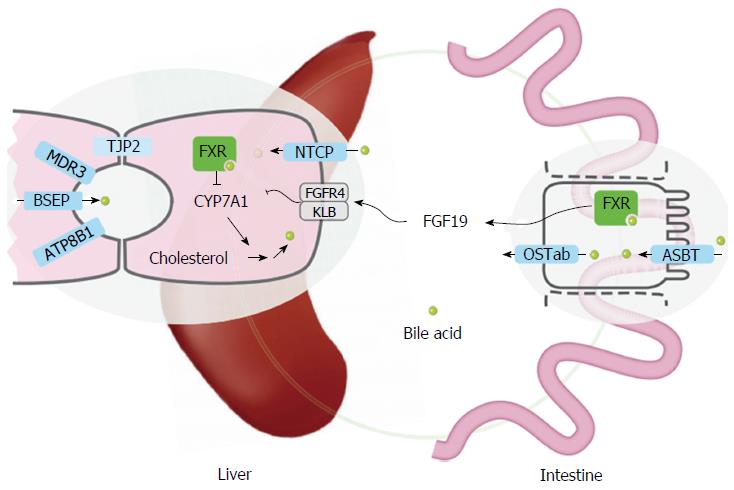Copyright
©The Author(s) 2017.
World J Gastroenterol. Feb 7, 2017; 23(5): 763-775
Published online Feb 7, 2017. doi: 10.3748/wjg.v23.i5.763
Published online Feb 7, 2017. doi: 10.3748/wjg.v23.i5.763
Figure 1 Overview of transporters and sensory proteins involved in hepatic bile flow (regulation).
Inherited cholestatic liver diseases are a consequence of mutations in ATP8B1, ABCB11 (encoding BSEP), ABCB4 (encoding MDR3), or TJP2. These 4 proteins are either expressed in the canalicular membrane or at the tight junctions of the canaliculi (TJP2). NTCP mediates uptake of conjugated bile acids into hepatocytes. ASBT mediates uptake of bile acids from the lumen into the enterocyte and OSTab the bile acid export from the enterocyte into the portal circulation. FXR is a nuclear receptor for bile acids, present in multiple tissues, including liver and intestine. Activation of FXR leads to the enhanced secretion of the hormone FGF19 into the systemic circulation. FGF19 is detected by the heteromeric receptor FGFR4/βKlotho on hepatocytes leading to repression of CYP7A1, and reduced bile acid synthesis. FXR: Farnesoid X receptor; NTCP: Sodium taurocholate cotransporting polypeptide; BSEP: Bile salt export pump; ASBT: Apical sodium-dependent bile acid transporter.
- Citation: van der Woerd WL, Houwen RH, van de Graaf SF. Current and future therapies for inherited cholestatic liver diseases. World J Gastroenterol 2017; 23(5): 763-775
- URL: https://www.wjgnet.com/1007-9327/full/v23/i5/763.htm
- DOI: https://dx.doi.org/10.3748/wjg.v23.i5.763









